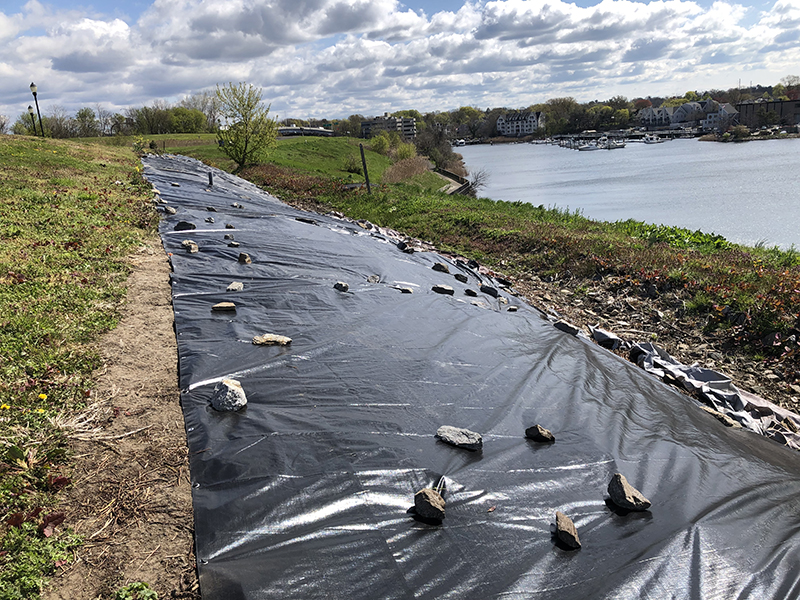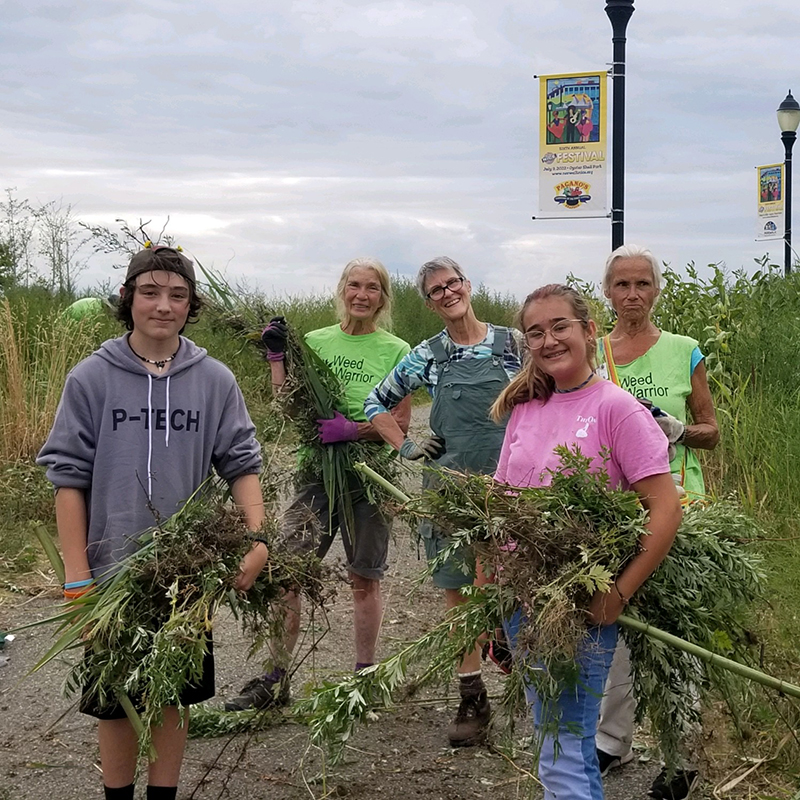Hundreds of volunteers have helped the Norwalk River Watershed Association (NRWA) and several partner organizations plant dozens of native trees, shrubs, and perennials to help restore 10 acres of urban watershed habitat in Norwalk and along the Norwalk River Valley Trail in Wilton. Along the way, they’ve learned about the benefits of plants and improved the quality of life and environment for urban neighborhoods.

Photo Credit: Louise Washer
The NRWA worked with community and corporate volunteer groups to plant 30 native trees, as well as native shrubs and perennials, at each of two Norwalk parks, Woodward Avenue Park and Oyster Shell Park, says Louise Washer, president of the NRWA. A nearly $50,000 National Fish and Wildlife (NFWF) Five Star and Urban Waters Restoration program grant funded those 60 trees, as well as 18 trees that the city of Norwalk crews simultaneously planted along Woodward Avenue.

The Hudson to Housatonic (H2H) Regional Conservation Partnership (RCP) put together the collaborative grant proposal to NFWF on behalf of partners. Partners identified the areas of highest conservation value in the region through a strategic planning process several years earlier. They learned they needed to develop a plan that considered the value of conservation activities in human-dominated landscapes, which the former strategic planning was unable to capture. Partners from NRWA and the Norwalk Land Trust (NLT) stepped forward as interested stakeholders in piloting the process for the City of Norwalk. A year in development, the Norwalk Urban Conservation Mapping tool and guide were born. NRWA and NLT used this tool in applying for the NFWF grant to identify the areas in the city that would most benefit from restoration and tree planting.
“Habitat restoration through invasive plant removal and planting natives is the ultimate goal,” of the grant Washer says, but “you have to sugarcoat it with tree planting.” Washer made use of corporate team-building volunteer days that fulfilled multiple objectives. With a captive audience of volunteers drawn in by the chance to plant trees, leaders use the opportunity to educate people about invasive identification and removal, and why it matters, while also capitalizing on the free labor. The experience was so successful that RCP partners converted some of those one-day volunteers into regular helpers.

“We always start these tree plantings with a workshop,” she says. Leaders show participants how to use the iNaturalist Seek app to identify invasives. At one park, a Norwalk Community College student – there because her environmental science professor offers extra credit – walked around the perimeter using the Seek app to identify the plants, and Washer observed the experience appeared to have lit a spark in the student.
One goal of the NFWF grant was to improve the tree canopy in underserved neighborhoods with little tree cover. Using the Urban Mapping tool, project partners identified a street in South Norwalk to focus their efforts. There was no space to plant trees between the sidewalk and the roads, Washer says, so NRWA volunteers, along with a city council member, walked door-to-door to ask property owners to allow the trees to be planted on their property. The city Public Works Department helped out by having staff dig the holes for the street trees ahead of time.
The grant also helped support ongoing NRWA projects to restore both parks. Teams of volunteers help with invasive removal, watering, and planting. At Oyster Shell Park, the volunteers call themselves the Weed Warriors and meet twice weekly all year. The volunteers work in formerly red-lined coastal neighborhoods that now face floods, urban heat island effects, and the most depleted tree canopy in southwest Connecticut. “Trees can go such a long way in providing habitat, cleaning water, and cooling the air,” Washer says.

Photo Credit: Louise Washer
“The grant definitely helped us form lasting relationships with these corporate groups. It was a combination of the end of the pandemic and our having the funding to buy 70 trees that made this all possible,” she says. Since 2017, the NRWA has planted 115 trees and about 400 shrubs combined at Woodward Avenue Park and Oyster Shell Park.
Beginning about five years ago, with a crew of community volunteers, they planted trees on the banks of the Norwalk River in an area formerly overrun by invasive Japanese knotweed, mugwort, and phragmites. Led by a woman who owns a landscaping company, volunteers working Wednesday and Saturday mornings have been chipping away at the invasives in an effort that “completely changed that park,” Washer says. Along the way, the volunteers became a community of people who meet for drinks and to celebrate birthdays.
“It’s making a difference in these two parks that you can see. When you’re there, with the community of people, it gives me the best feeling,” she says.

The group included both retired and working people who became devoted in the long-term outcome of the area, she says. By including working people and college students rather than just retirees, the volunteer base was more diverse in terms of age and race than is typical, she says. “They have an investment in the bigger picture there, as opposed to just this one team-building event.”
The active group of volunteers has grown, and the volunteers have become more engaged. While habitat restoration is the primary goal, an added benefit that grows out of the initiative is educating the volunteers, Washer says. They’ve received native plant lists, Pollinator Pathway brochures, and fact sheets about how to bring more butterflies to their yards.
Project partners include the NRWA, Norwalk Land Trust, the City of Norwalk, H2H and Norwalk Pollinator Pathway partners, community volunteers, the U.S. Fish & Wildlife Service Stewart B. McKinney National Wildlife Refuge, Copps Island Oysters, the Rowayton Library, Norwalk Tree Alliance, and the Norwalk Tree Advisory Committee.